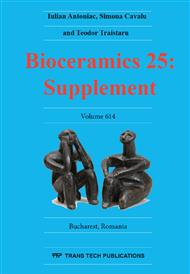[1]
K.J. Söderholm, M. Zigan, M. Ragan, W. Fischlschweiger, M. Bergman, Hydrolytic degradation of dental composites, J Dent. Res. 63, 10 (1984), 1248-1254.
DOI: 10.1177/00220345840630101701
Google Scholar
[2]
N. Moszner, S. Klapdohr, Nanotechnology for dental composites, International Journal of Nanotechnology, 1 (2004), 143-148.
Google Scholar
[3]
J. Martos, P.W. Rodo Osinaga, E. de Oliveira, L. A. Suita de Castro, Hydrolytic degradation of composite resins: effects on the microhardness, Materials Research, 6 (2003), 599-604.
DOI: 10.1590/s1516-14392003000400029
Google Scholar
[4]
C. Tamas, M. Moldovan, C. Prejmerean, A. Colceriu, G. Furtos, L. Vezsenyi, D. Prodan, V. Simon, Structure and properties of inorganic fillers for dental composites, Journal of Optoelectronics and Advanced Materials, 6 (2005), 2849-2852.
DOI: 10.1016/j.msec.2005.01.016
Google Scholar
[5]
K. Langer, M. Raith, Infrared spectra of Al-Fe(III)-epidotes and zoisites, Ca2(Al1-pFe3+p)Al2O(OH)[Si2O7][SiO4], American Mineralogist, 59 (1974), 1249 – 1258.
Google Scholar
[6]
J.L. Ferracane, H.X. Berge, J.R. Condon, In vitro aging of dental composites in water—Effect of degree of conversion, filler volume, and filler/matrix coupling, J. Biomed. Mater. Res. 42 (1998), 465-472.
DOI: 10.1002/(sici)1097-4636(19981205)42:3<465::aid-jbm17>3.0.co;2-f
Google Scholar
[7]
A. F. Bettencourta, C.B. Nevesb, M. S. de Almeidab, L.M. Pinheiroa, S. Arantes e Oliveirab, L. P. Lopesb, M.F. Castroa, Biodegradation of acrylic based resins, Dental Materials, 26 (2010), e171–e180.
Google Scholar
[8]
S. Rüttermann, I. Dluzhevskaya, C. Großsteinbeck, H. Wolfgang, M. Raab, R. Janda, Impact of replacing Bis-GMA and TEGDMA by other commercially available monomers on the properties of resin-based composites, Dental materials, 26 (2010), 353 – 359.
DOI: 10.1016/j.dental.2009.12.006
Google Scholar
[9]
I.D. Sideridou, M.M. Karabela, E. Ch. Vouvoudi, Physical properties of current dental nanohybrid and nanofill light-cured resin composites, Dental Materials, 27(2011), 598–607.
DOI: 10.1016/j.dental.2011.02.015
Google Scholar
[10]
N. da Rocha Svizeroa, V. de Freitas Carvalhoa, J. Bechtoldb, R. C. Bruschi Alonsoc, M. T. Attad, P. H. Perlatti D'Alpinoc, Hydrolytic degradation of a resin composite as a function of the curing tip distance and aging, Materials Research. 14 (2011).
Google Scholar
[11]
F. Monticelli, R. Osorio, M. Toledano, F. R. Tay, M. Ferrari, In vitro hydrolytic degradation of composite quartz fiber-post bonds created by hydrophilic silane couplings, Operative Dentistry, 31-6 (2006), 728-733.
DOI: 10.2341/05-151
Google Scholar
[12]
C. Domingoa, R.W. Arcı´sa, E. Osoriob, R. Osoriob, M.A. Fanovicha, R. Rodrı´guez-Clementea, M. Toledanob, Hydrolytic stability of experimental hydroxyapatite-filled dental composite materials, Dental Materials, 19 (2003), 478–486.
DOI: 10.1016/s0109-5641(02)00093-3
Google Scholar
[13]
J.L. Ferracane, Hygroscopic and hydrolytic effects in dental polymer networks, Dental Materials, 22(2006), 211-222.
DOI: 10.1016/j.dental.2005.05.005
Google Scholar


